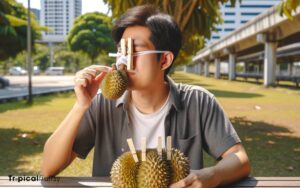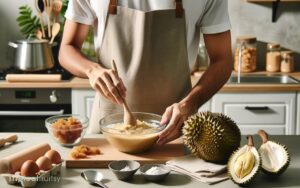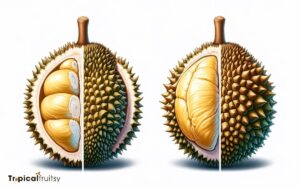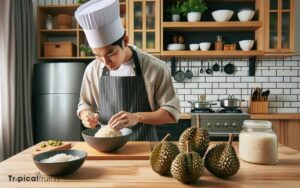Is Marang and Durian the Same? Comparison!
Marang (Artocarpus odoratissimus) and durian (Durio spp.) are not the same; they are two distinct tropical fruits with unique characteristics despite their similar appearances and strong smells.
Marang is part of the Moraceae family, related to jackfruit and breadfruit, while durian is categorized under the Durionaceae family.
Marang and durian can often be mistaken for each other due to their spiky exteriors and strong aromas.
However, they have several differences:
Discover the distinct profiles of marang and durian, two tropical delights with unique tastes and textures that distinguish them in the fruit world.
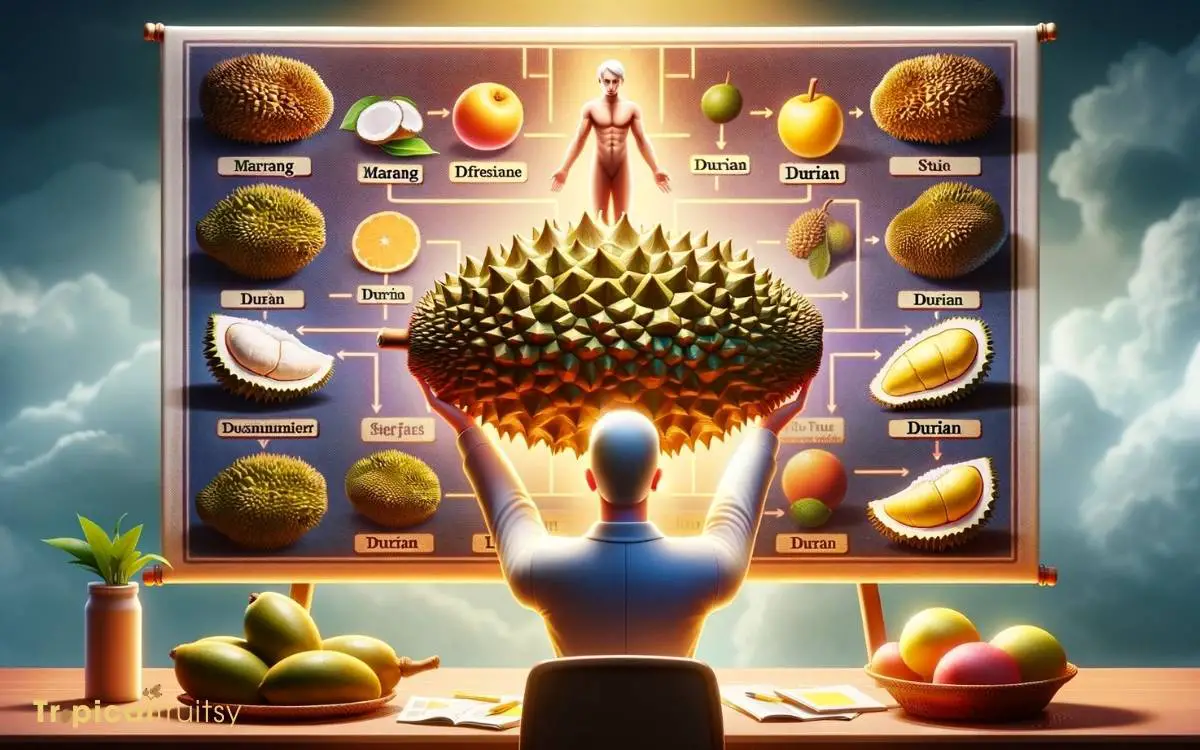
Key Takeaway
Marang vs. Durian: Understanding the Differences
| Characteristic | Marang (Artocarpus odoratissimus) | Durian (Durio spp.) |
|---|---|---|
| Family | Moraceae | Durionaceae |
| Taste | Sweet, reminiscent of banana and mango | Complex, sweet and savory, creamy |
| Texture | Soft and fibrous | Creamy and custard-like |
| Color | Yellow to orange when ripe | Typically yellow or red |
| Size | Medium, similar to a cantaloupe | Large, up to 30 cm in length |
| Cultural Significance | Less prominent in international markets | Known as the ‘King of Fruits’ in Southeast Asia |
| Edibility | Eaten fresh, used in desserts | Eaten fresh, used in various culinary applications |
Unveiling the Marang
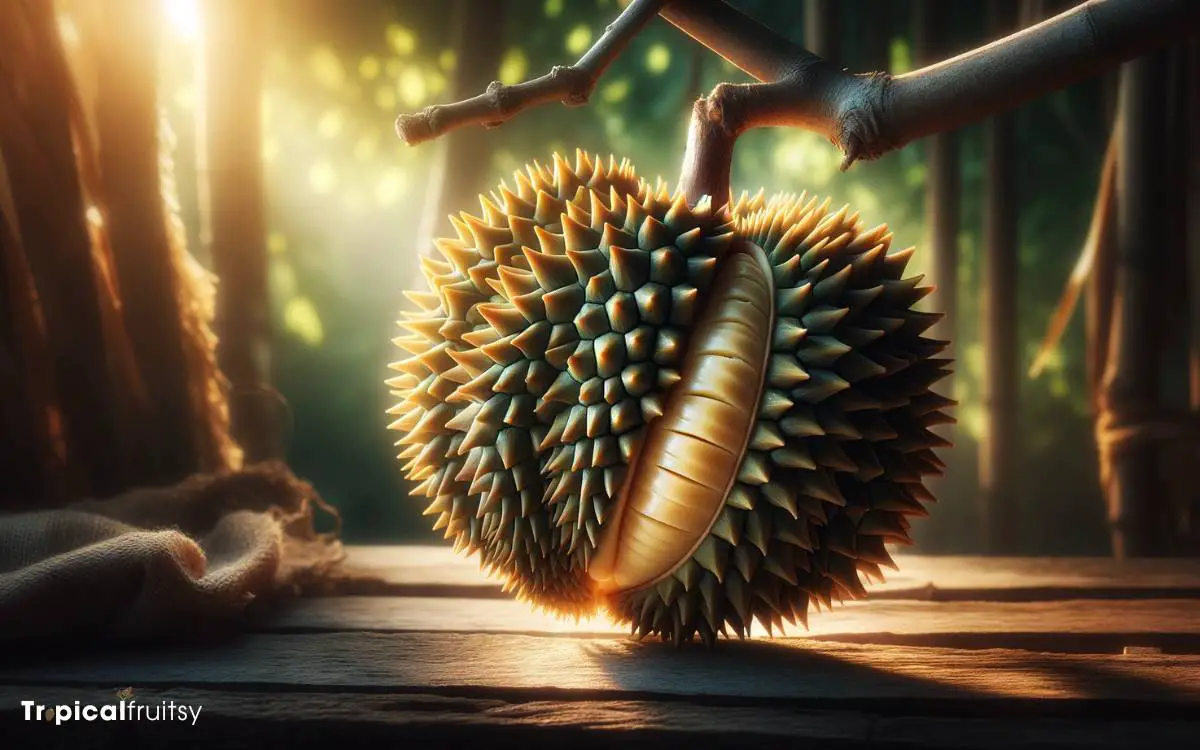
While both fruits belong to the Moraceae family, the marang (Artocarpus odoratissimus) is a distinct species with its own unique characteristics and qualities.
Originating from the island of Borneo, it thrives in the humid tropical climates of Southeast Asia.
The marang fruit is notable for its spiky exterior, resembling breadfruit and jackfruit in texture and form. Its interior, however, reveals a creamy, custard-like flesh, sectioned into lobes containing seeds.
This aromatic fruit exudes a strong, sweet scent that becomes more pronounced as it ripens.
The marang’s nutritional profile is rich in carbohydrates, dietary fiber, vitamins, and essential minerals, making it a valuable food source.
Unlike the pungent durian, marang’s aroma is generally considered pleasant and inviting, enhancing its appeal among tropical fruit enthusiasts.
Durian: The King of Fruits
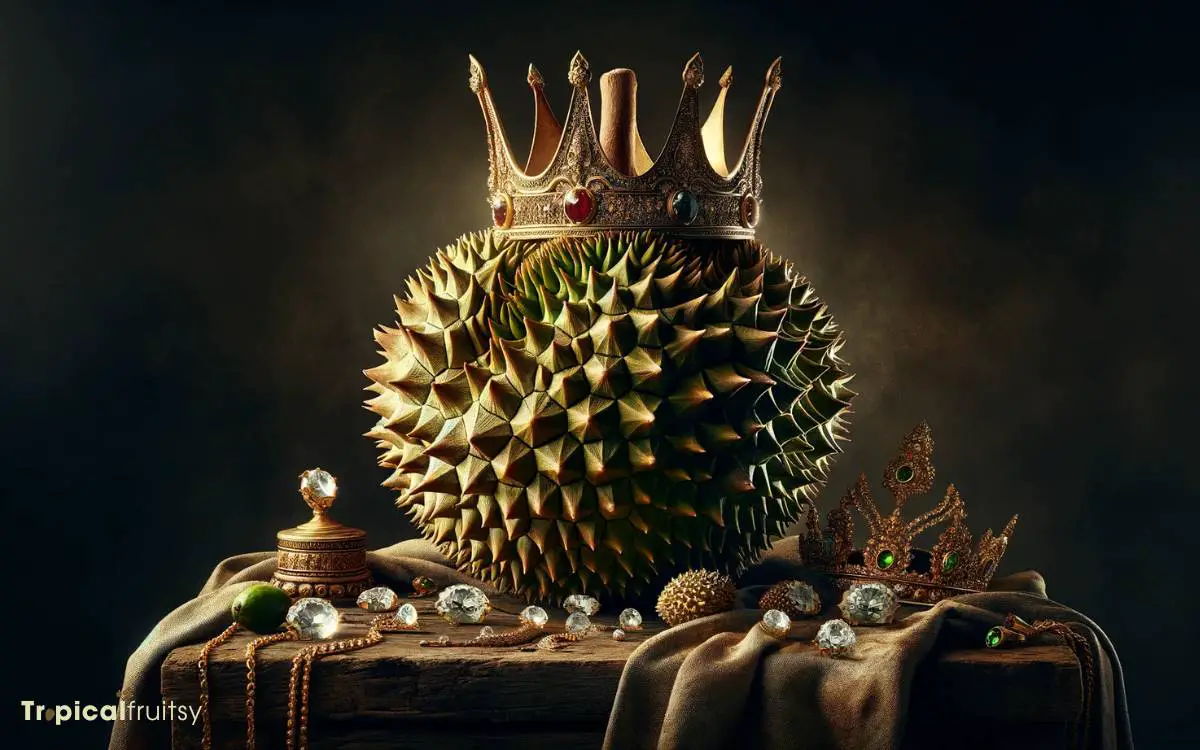
The durian (Durio spp.), in contrast to the marang, is revered in Southeast Asia as the ‘King of Fruits’ due to its distinctive size, formidable thorn-covered husk, and uniquely potent aroma.
This tropical fruit’s impact on the senses is matched by its nutritional profile and culinary versatility.
Key aspects of the durian include:
- Culinary Diversity: Durian is used in a wide array of dishes, from sweet desserts to savory meals, demonstrating its flexibility despite the strong flavor.
- Nutritional Value: Rich in vitamins, minerals, and dietary fiber, it provides a substantial health benefit.
- Aroma Profile: Its pungent smell is so intense that it is banned in certain public spaces, yet it is considered an aphrodisiac by some enthusiasts.
Understanding durian requires delving into its complex characteristics that command both respect and curiosity from fruit aficionados worldwide.
Origins and Habitat

Durian’s origins trace back to the rainforests of Borneo and Sumatra, where its cultivation has spread throughout Southeast Asia, reflecting the region’s diverse ecological habitats.
Famed for its pungent aroma and distinctive taste, the durian tree, Durio zibethinus, thrives in tropical climates with high humidity and abundant rainfall.
These conditions are crucial for the development of its large, spiky fruits, which demand extensive care and specific soil types, rich in organic matter, to flourish.
The durian’s natural habitat is characterized by a canopy structure that provides shade and protection, supporting the species’ growth in the wild and in managed agricultural systems.
The fruit’s ecological niche requires elevation ranges typically between sea level and 800 meters, with optimal growth occurring in areas where ambient temperatures rarely drop below 22°C (72°F).
A Tale of Textures
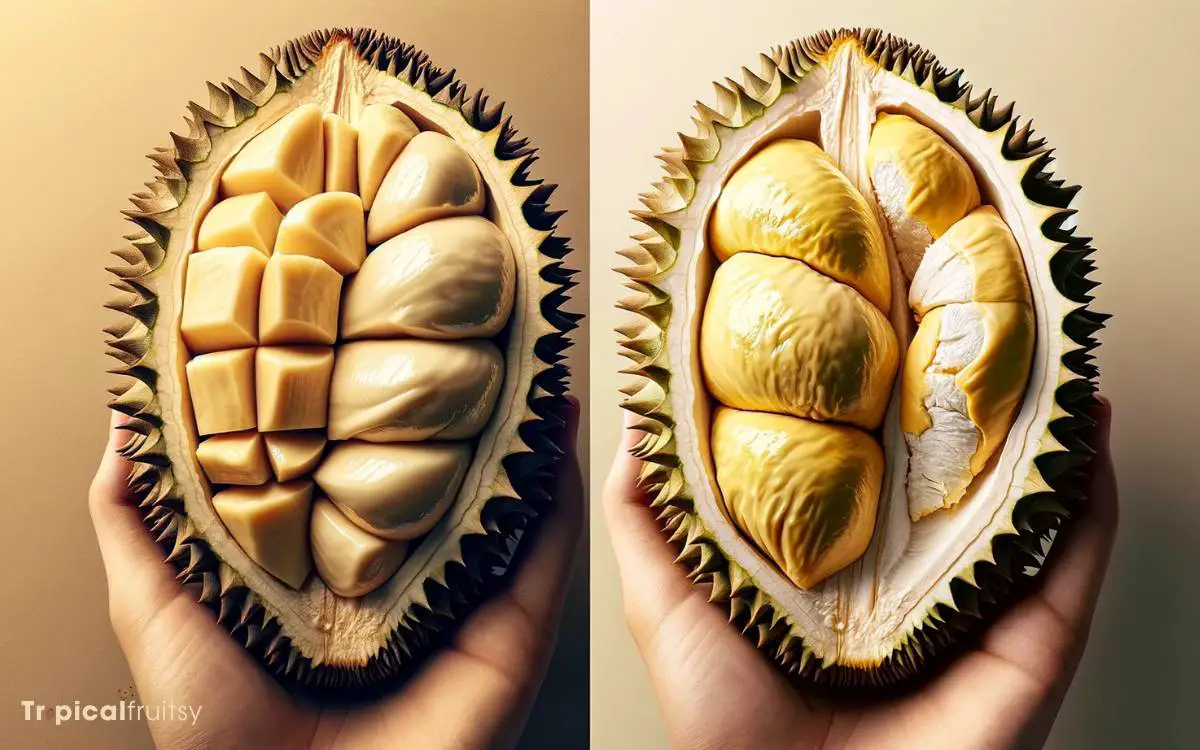
Despite their superficial similarities, the textures of marang and durian fruits are distinctly different, with durian having a creamy, custard-like consistency, whereas marang offers a firmer, fibrous flesh.
When evaluating these textures, several aspects merit consideration:
- Mouthfeel: Durian’s texture is often likened to a rich mousse due to its smooth, dense, and buttery quality, enveloping the palate in a way that is quite unique among fruits.
- Flesh integrity: Marang segments are more akin to certain types of pears or jackfruit, maintaining their structural integrity, providing a satisfying bite.
- Consistency Variations: The texture of durian can vary depending on its ripeness; an overripe durian may become excessively soft and somewhat liquefied, whereas marang retains its form better through varying stages of ripeness.
Understanding these textural differences is crucial for consumers and culinary professionals alike when selecting and preparing these fruits for consumption.
Sensory Profile: Aroma
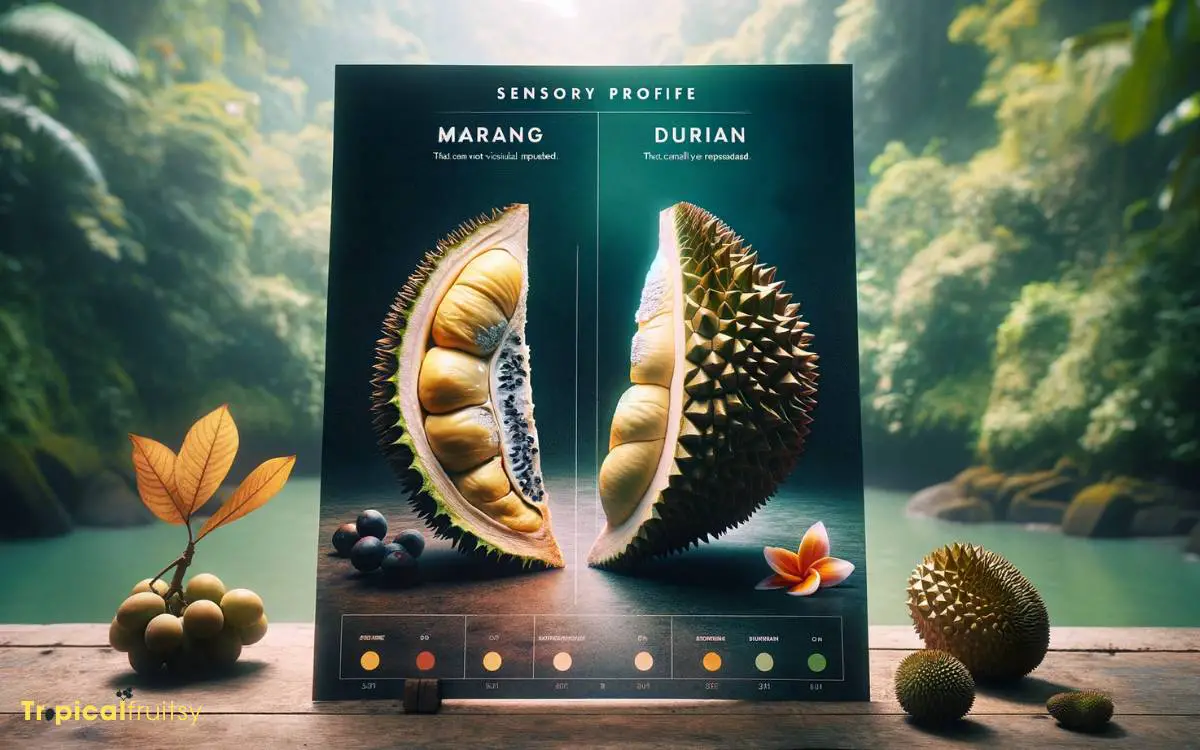
Moving from texture to aroma, both fruits emit potent fragrances, yet each carries a distinct olfactory signature that sets them apart.
The durian’s scent is often considered overpowering with a complex bouquet that is a blend of sweet, savory, and sulfurous elements.
In contrast, the marang’s aroma is comparably mild and reminiscent of a fruity and floral mix, with notes of banana and jackfruit.
To detail their aromatic profiles, the following table segregates the characteristic scents of each fruit:
| Aromatic Component | Durian | Marang |
|---|---|---|
| Primary Scent | Intense, sulfurous | Sweet, fruity |
| Secondary Notes | Sweet, creamy, almond-like | Floral, reminiscent of jackfruit and banana |
| Reaction | Polarizing, evokes strong opinions | Generally pleasant, more universally accepted |
| Sillage | Pervasive, lingering | Moderate, dissipates more quickly |
The Taste Test
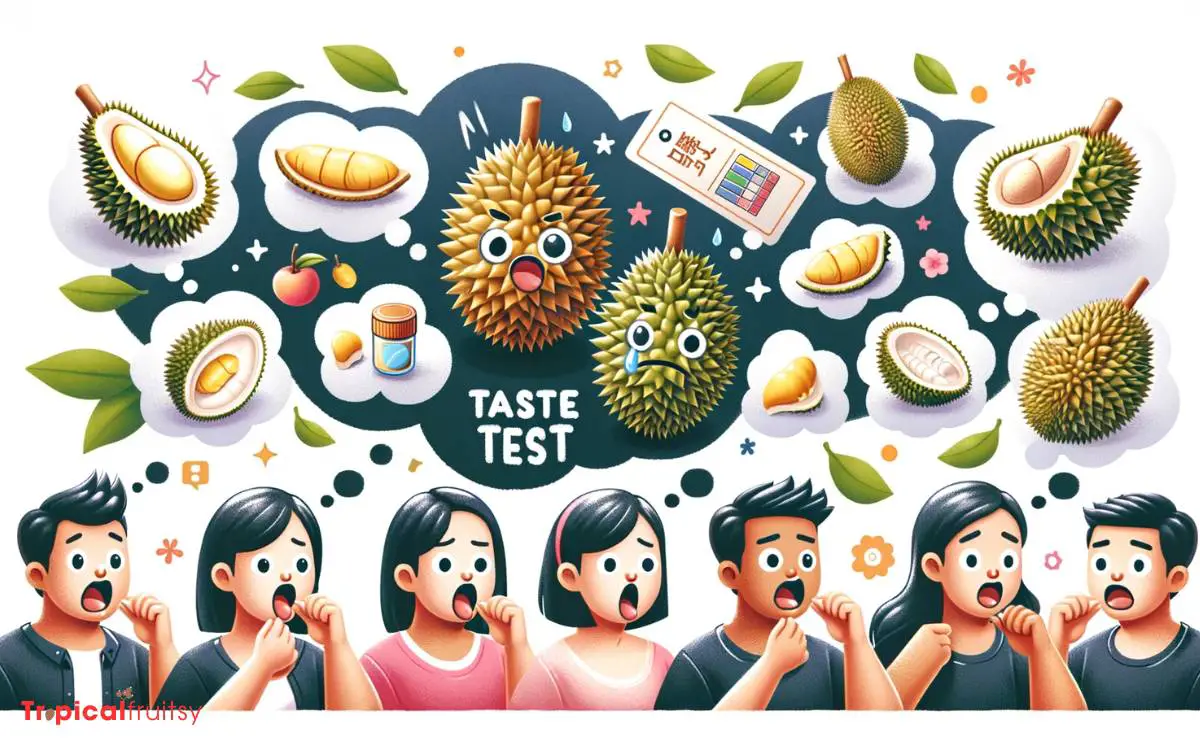
Conducting a taste test between marang and durian involves a systematic comparison of their flavor profiles. These profiles differ significantly in sweetness, bitterness, and umami qualities.
The textural characteristics of the fruits must also be evaluated. This includes examining the creaminess, fibrousness, and mouthfeel of each fruit.
These textural qualities provide critical sensory information that distinguishes one fruit from the other.
In addition to flavor and texture, the intensity and nuances of aroma play a pivotal role in the overall gustatory experience. Therefore, careful assessment of the aroma is necessary during tasting sessions.
Flavor Comparison
Upon conducting a taste test, it becomes evident that marang and durian, while both tropical fruits, offer distinct flavor profiles that set them apart from one another.
The sensory evaluation reveals:
- Marang: Subtly sweet with a hint of a floral bouquet, its creamy texture carries notes reminiscent of jackfruit and banana, yet with a less pervasive aroma than its counterpart.
- Durian: Boasts a complex flavor amalgam often described as a rich custard highly infused with almonds. Its scent, potent and divisive, ranges from sweetly fragrant to pungently musky, contributing to an intense, savory experience.
- Texture Contrast: Durian’s pulp is custard-like and creamy, while marang’s texture is firmer and more fibrous, providing a different mouthfeel.
These fruits, though comparable in some respects, deliver uniquely individual taste experiences.
Texture Differences
While both marang and durian have creamy textures, the marang’s flesh is comparatively firmer and less custard-like, which is particularly noticeable when conducting a tactile assessment during a taste test.
The durian, known for its rich, buttery consistency, exudes a potent aroma and yields a soft, almost pudding-like consistency that envelops the palate.
In contrast, marang offers a more resilient bite, a textural contrast that can be attributed to its denser cellular structure.
This distinction in mouthfeel is a critical parameter in differentiating the two fruits, with durian providing a more decadent, melt-in-your-mouth experience, while marang maintains a subtle integrity upon mastication.
Connoisseurs often reference this textural variance when distinguishing between the two fruits, underscoring the importance of sensorial diversity in tropical fruit profiles.
Aroma Intensity
How do the olfactory characteristics of marang and durian compare during a taste test, and what implications do these have for their sensory differentiation?
The aroma intensity of these fruits plays a crucial role in the overall sensory experience and distinction.
- Durian Aroma: Pungent and pervasive, durian’s aroma is often described as a complex mixture of sweet, creamy, and sulfurous notes, which can be overwhelming to the unaccustomed palate.
- Marang Aroma: Less intense and offensive, marang typically emits a sweet and fruity fragrance, reminiscent of a milder version of jackfruit or banana.
- Sensory Impact: Durian’s potent smell can significantly impact taste perception, often intensifying the sweetness and creaminess, while marang’s gentler aroma allows for a more nuanced flavor profile.
Understanding these factors is essential for fruit enthusiasts and professionals in the food industry to distinguish between marang and durian effectively.
Nutritional Comparison
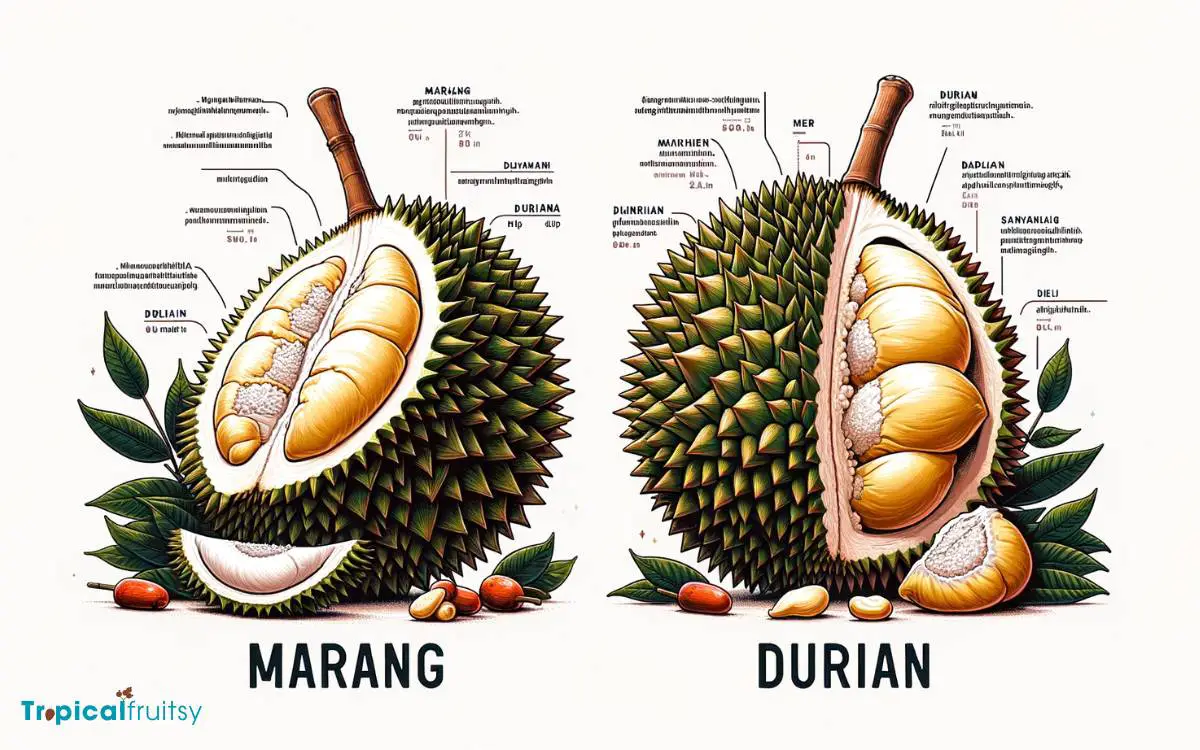
Turning to the nutritional profiles of marang and durian, it is crucial to analyze the caloric content, which has implications for energy intake and weight management.
A thorough examination of their vitamin and mineral composition will illuminate distinct health benefits and potential dietary applications.
Additionally, comparing the fiber content of both fruits is essential for understanding their roles in digestive health and satiety levels.
Caloric Content Differences
Regarding the caloric content, marang and durian differ significantly in their nutritional profiles, with durian having a higher calorie count per serving.
When evaluating the energy provided by these fruits, it is crucial to consider the following aspects:
- Caloric Density: A typical serving of durian can contain around 357 calories, largely due to its rich composition of fats and carbohydrates.
- Fat Content: Durian has a higher fat content, which contributes to its caloric density; marang, in contrast, has less fat and therefore fewer calories.
- Carbohydrate Comparison: Both fruits are high in carbohydrates, but the caloric impact is greater in durian due to its larger proportion of sugars and complex carbs.
Vitamin and Mineral Profiles
The vitamin and mineral content of marang and durian reveals distinct nutritional advantages unique to each fruit.
Durian is renowned for its high vitamin C content, essential for immune system function, alongside a notable amount of thiamin (vitamin B1), which is critical for energy metabolism.
It also supplies potassium, crucial for maintaining electrolyte balance and muscular function.
Marang, on the other hand, boasts an impressive array of B vitamins, including niacin (B3), which supports enzyme function and energy production, and riboflavin (B2), important for cellular growth and function.
It also contains calcium and iron, which are vital for bone health and oxygen transport in the blood, respectively.
Together, these profiles underscore the importance of both fruits as valuable components of a nutritionally diverse diet.
Fiber Content Comparison
Beyond their vitamin and mineral composition, marang and durian differ significantly in terms of dietary fiber content, a crucial element for digestive health.
Fiber plays an essential role in maintaining a healthy gut, influencing both bowel regularity and microbial balance.
To elucidate the fiber distinctions between these two fruits, consider the following:
- Marang: Typically contains a moderate amount of dietary fiber, contributing to satiety and supporting normal digestive functions.
- Durian: Often boasts a higher fiber content than marang, which can be more beneficial in promoting a healthy digestive tract and preventing constipation.
- Impact: The fiber disparity may affect individual dietary choices, particularly for those seeking to increase their fiber intake for health reasons.
Culinary Uses and Recipes

We can explore a variety of culinary applications for marang and durian, each fruit offering distinct flavors and textures that inspire unique recipes.
Marang fruit, with its milder taste and creamy texture, is often eaten fresh or incorporated into desserts such as ice cream and fruit salads.
Its subtle sweetness complements dairy bases well, enabling the creation of sophisticated flavor profiles when blended with spices like cinnamon or vanilla.
Durian, on the other hand, is known for its pungent aroma and bold taste, which can be divisive. Nevertheless, durian’s custard-like pulp is used extensively in Southeast Asian cuisine, featuring in both sweet and savory dishes.
Traditional recipes include durian pancakes, durian sticky rice, and even durian-flavored confectioneries.
The complexity of durian also lends itself to experimental gastronomy, where it is used to infuse dishes with its unmistakable essence.
Cultural Significance and Availability
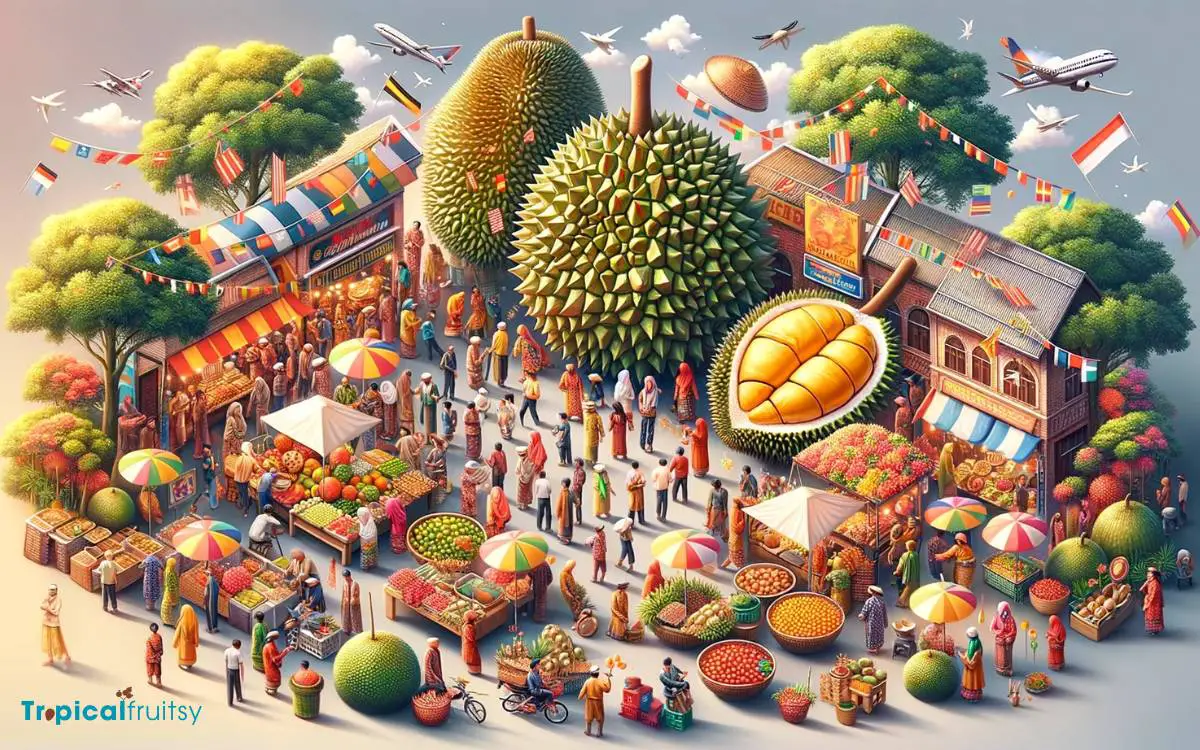
Despite similarities in their exotic appeal, marang and durian hold distinct cultural significances and vary in availability across different regions.
The durian, often revered as the ‘King of Fruits’ in Southeast Asia, has a longstanding prominence in social and cultural ceremonies. Conversely, marang, while enjoyed locally, does not command a similar widespread cultural status.
Their availability is influenced by geographical, ecological, and economic factors, as outlined below:
- Geographical Distribution: Durian is cultivated extensively in Thailand, Malaysia, and Indonesia, while marang is primarily found in the Philippines and parts of Borneo.
- Ecological Requirements: Durian trees require specific climatic conditions to thrive, making them less widespread, whereas marang grows in a broader range of environments.
- Economic Impact: The durian industry is a significant economic driver in Southeast Asia, leading to greater investment in its cultivation and distribution.
Conclusion
Marang and durian, while both exotic fruits hailing from Southeast Asia, stand distinct in their sensory offerings and cultural imprints.
The marang whispers with a gentler aroma, while durian declares its presence with olfactory might.
Each fruit, with its unique texture and taste, contributes diversely to nutritional benefits and culinary landscapes.
Their storied existence weaves a rich tapestry of cultural heritage, ensuring that both fruits maintain their revered status within their native realms and beyond.

